The global data center market is vast and growing rapidly, with approximately 10,978 data centers worldwide today.
Data centers account for 1.3% of the world's electricity consumption, a relatively low percentage but grew by 70% between 2015 and 2022. Although significant progress has been made in data centre performance in recent years, further efforts by the government and industry are needed to improve energy efficiency and curb energy demand, thereby rapidly reducing emissions over the next decade to achieve a net-zero emissions scenario by 2050.
From this perspective, it is necessary to make the right choices in data center design, where energy efficiency is an important factor in minimising environmental impact. Reducing the environmental impacts of digital infrastructure is particularly related to cooling systems, whose consumption constitutes on average 30% of data center energy use.
Overview of a data center cooling system
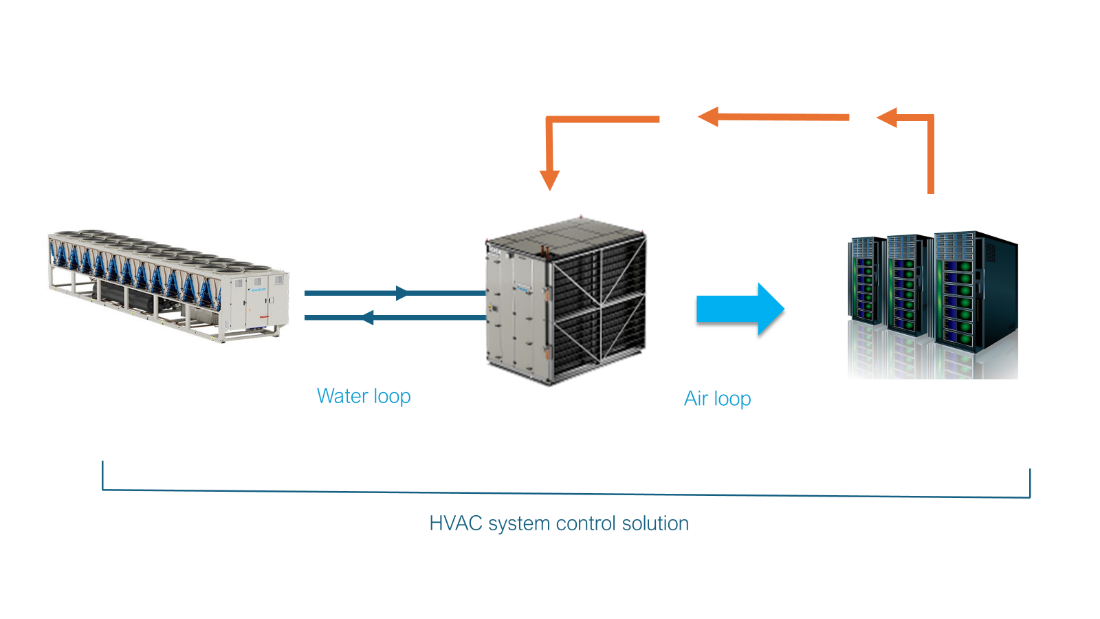
The schematics above describe a typical HVAC plant for a data center, and introduce the main elements of Daikin’s solution, including several components:
- Air-to-water chiller
- Computer Room Air Handling (CRAH) unit
- Control systems
- After-sales services
In this article, we will discuss the main challenges in the choice of chillers for data centers and how Daikin can support overcoming those challenges.
Challenge #1: ambient temperature conditions
As mentioned, we are experiencing increasingly rapid growth of data centers in all parts of the world. When designing the data center infrastructure, it is appropriate first to make some considerations regarding the external ambient operating temperatures in which the HVAC systems will perform. It is necessary to evaluate the system's equipment and its operating ranges to make sure that it will work properly at the required conditions.
Given the strong growth of data centers also in parts of the world where temperature conditions are extreme, there is a need for cooling systems that can guarantee and ensure proper operation in both warm and cold regions, for example, the Middle East and Northern Europe, respectively.
Reason #1: To overcome this challenge, Daikin can guarantee with its chillers an operating range from -30°C to +55°C ambient temperature, thereby enabling projects on a global scale.
Challenge #2: Optimize the installation space
The indoor design of the data center, the related IT power, and the capacity of the cooling system are strongly tied topics within a data center project. As for any other building, even in data centers the installation space for HVAC equipment is limited.
Reason #2: Despite data centers may require hundreds of megawatts of cooling capacity, Daikin supplies extremely compact air-cooled chillers, allowing them to be fitted in restricted areas. This is specifically true for free cooling units, whose configuration does not exceed the unit footprint.
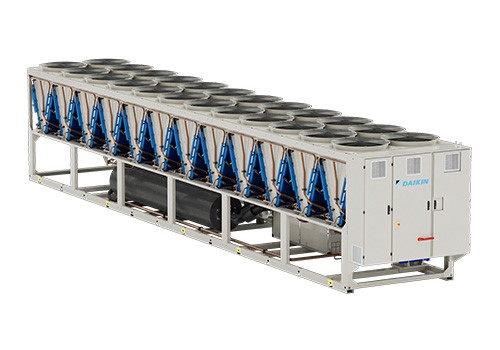
This is a result of a re-design of the condensing section, which has been optimised resulting in a reduction of units’ length. This is particularly important because, given the limited space for installation, it saves space by allowing further redundancy of capacity (where needed) and easiness of maintenance activities.
Challenge #3: how to cut operating costs and limit environmental impact
Given the large size of the applications, the implementation of strategies to keep operating costs low represents a priority. Containing operating costs is directly related to the need to reduce the environmental impact of the various installations that are implemented. As for the cooling system, most of the energy consumption is due to the operation of the chiller units. Therefore, 6 strategies might be pursued to cut operating costs and reduce environmental footprint:
- Select chillers ensuring optimal performance in part load conditions
- Include free-cooling configuration in chillers’ selection
- Adjust cooling system design allowing chillers to work with a high evaporator leaving water temperature
- Implement control solutions to cut costs by enhancing system efficiency
- Design the cooling system allowing to reuse of waste heat from the data center for district heating purposes
- Add active harmonic filters to limit harmonic distortion related to chillers
Optimize performance at part loads
Part loads represent more than 95% of the operating time, due to varying ambient conditions (temperature, humidity) in the installation location. Being a critical aspect to consider, proper considerations must be made on the compressor technology mounted onto the chiller, and most importantly on the availability of a variable frequency drive (VFD) to modulate the compressor’s capacity.
Reason #3: Daikin's in-house single-screw compressor is a very efficient component by design. It also integrates the Variable Volume Ratio (VVR) technology to adjust the compressor’s geometry according to the real operating conditions. That is, VVR consists of a sliding valve used to modulate the compression ratio, enhancing the efficiency of the compressor with varying ambient conditions. Furthermore, the Daikin single-screw compressor is also equipped with an integrated VFD, also designed and manufactured by Daikin, mounted onto the compressor, and cooled down by refrigerant.
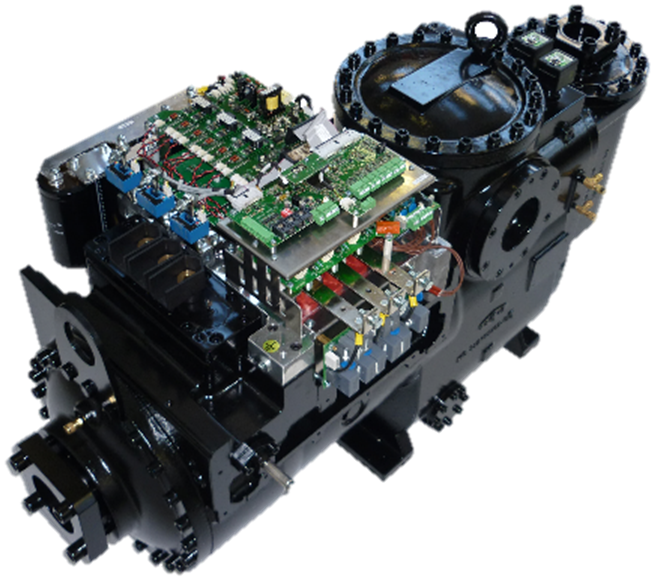
Free cooling to further reduce energy consumption
An additional help to further reduce electricity consumption is the use of Free Cooling technologies, because when outdoor temperatures are favourable, chillers can turn off compressors and take advantage of the low outdoor temperature to chill water.
Reason #4: Daikin offer different types of free-cooling configurations from 150 to 2150 kW of cooling capacity also including glycol-free systems, allowing savings for the pumping system as well.
Higher chiller leaving water temperature for further system optimization
A further possible reduction in consumption is related to the design temperatures of the data center. Indeed, when cold and hot aisles are separated, the cooling system can operate at higher temperatures, even in the range of 25 to 30 °C. This leads to benefits in terms of chillers’ efficiency and thereby reduced running costs.
Reason #5: Daikin's new range of air-cooled chillers can supply an evaporator leaving water temperature of up to +30°C. This temperature choice also increases the relevance of free cooling operation as the ambient temperature changes, which is particularly relevant for countries with mild (e.g. Southern Europe, Australia) or even warmer climates.
System control solutions to further raise efficiency
As mentioned, data centers often require multiple chillers to reach the cooling capacity requirement. This implies that it is not sufficient to consider the efficiency of a single chiller to ensure the efficiency targets of the whole cooling system. Therefore, higher-level control solutions should be considered to optimise performance of groups of units.
Reason #6: In this sense, Daikin offers an Intelligent Data Center Manager (iDCM). It is an external panel that controls up to 20 chillers, including Primary pumps management and free cooling mode. iDCM is designed to ensure maximum reliability and leverages an advanced machine learning algorithm, working based on manufacturer data and live data recorded on site. iDCM can ensure an increase in system efficiency up to 10% for the mechanical cooling system and up to 15% for the free cooling integrated system compared to standard control solutions. As well, this control panel is fully suitable for TIER III DataCenter and as a customised execution, also for TIER IV.
Recovery of waste heat for district heating
Ideally, all the electricity consumed by IT is converted into heat, and the effective removal of which is one of the primary needs of data center facilities. Heat is a byproduct of data center operations, but it is available at relatively low temperature and for this reason do not find practical use so is wasted to the ambient. If that heat could be made available at a higher temperature it could be reused instead of being wasted into the environment, however, becoming a valuable commodity for different purposes. As much as 90% of the energy used by data center IT equipment can be recovered as heat, providing thousands of megawatts of thermal power globally.
Most data center heat recovery projects rely on district heating networks as heat off-takers. Reason #7: In this sense, Daikin can propose solutions to recover the heat produced by data center. The scheme below describes a possible scenario, where a water source heat pump extracts the heat from data center loop, raise the temperature to a useful level to serve a heating purpose (for example, a district heating loop). The air-cooled chiller will then see a lower cooling demand thanks to the operation of the water source heat pump which extracts the heat from the loop. Recovering the otherwise wasted heat from the data center loop increases the whole system efficiency.
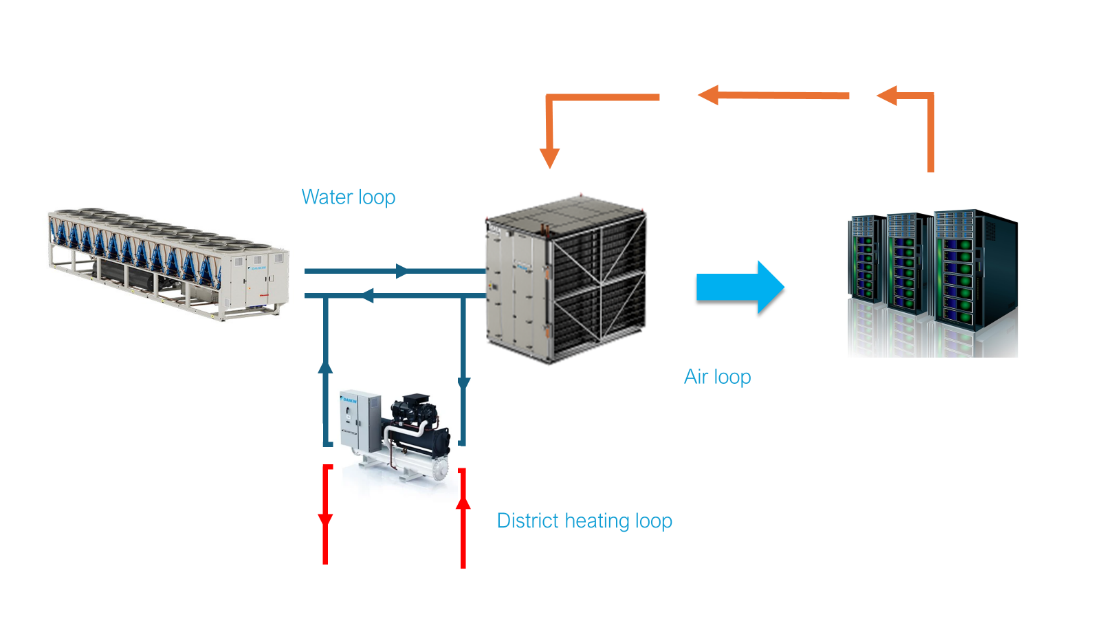
Still on heat reuse, there is another solution that Daikin can provide. The scheme below describes the plant layout. In this case, heat is recovered directly from the air-cooled chiller while working in mechanical cooling mode. This is ensured by means of an additional plate-to-plate heat exchanger placed in series with the condensing section. That heat is then supplied to the district heating system. Such a solution can be integrated within a free cooling chiller configuration as well, thereby offering facility managers a competitive alternative to satisfy heating needs and lower operating costs simultaneously.
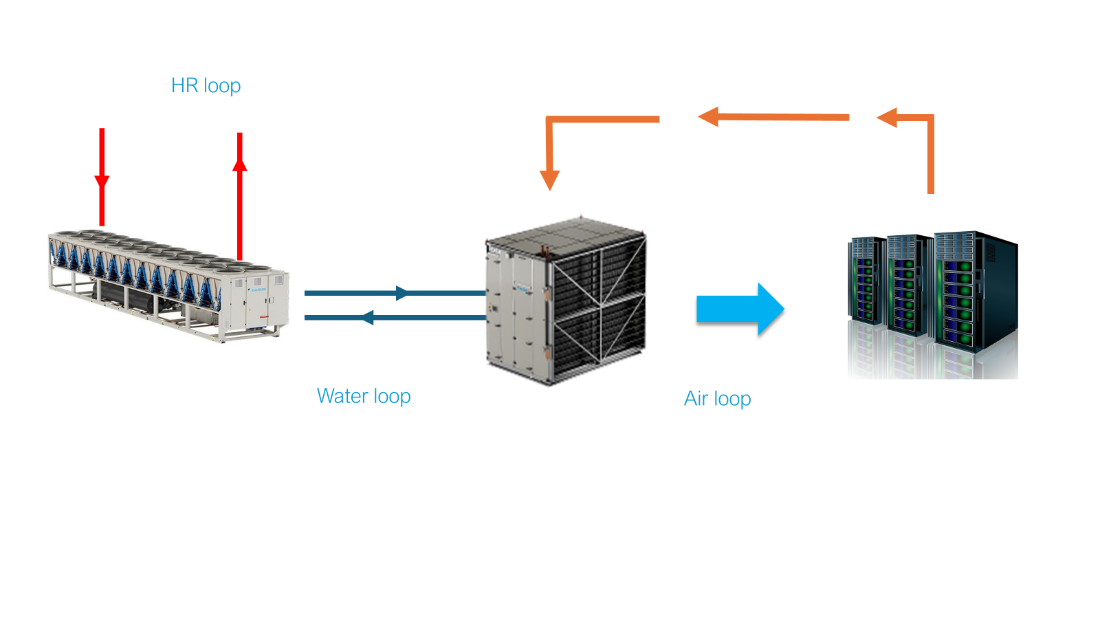
Reducing harmonic distortions
Harmonic distortion is caused by nonlinear loads such as power electronic devices, variable frequency drives, and certain types of lighting, which inject harmonic currents into the power system. That said, harmonic distortion can happen in data centers. Harmonic distortion causes additional power consumption in electrical systems. It can lead to increased energy losses and reduced efficiency, resulting in higher energy costs. Low harmonic distortion helps minimise these losses, improving energy efficiency and reducing operational expenses. Many countries have established regulations and standards to limit the level of harmonic distortion produced by electrical equipment. By keeping harmonic distortion within the prescribed limits, manufacturers and data center operators can ensure compliance with these standards.
Active harmonic filters (AHFs) are electronic devices used to reduce harmonic distortion in electrical systems. They are capable of dynamically compensating for harmonic currents in real time, thereby improving the power quality of the system. AHFs actively monitor the harmonic currents and generate compensating currents that cancel out the harmonics, resulting in a reduction in Total Harmonic Distortion (THD).
Reason #8: As chillers may generate harmonic distortions, Daikin offers a unique solution for active harmonic filtration. Based on the same proprietary technology used for the compressor drive, the active harmonic filter by Daikin is fully integrated into the chiller. The device is installed inside the electrical panel, cooled by the refrigerant from the chiller circuit, ensuring temperature control in all operating conditions regardless of environmental conditions. Being the AHF fully integrated, no additional space, installation, and maintenance are required. As well, Daikin AHF is fully assembled and tested directly in the factory.
Challenge #4: ensure reliability of equipment
The management of a data center is particularly challenging and complex, as the main objective is to ensure continuous operation all day, every day. This places high demands on the reliability and quality of components, including the HVAC system. Concerning the causes of system failures, the Uptime Institute reports in a survey that 14% of downtime episodes are caused by cooling system issues, negatively impacting the business. In addition to that, it is reported that the causes of downtime are predictable in most cases (76%), as they are often related to human error. In this area, problems due to inadequate equipment management and maintenance are significant (36%). For this reason, the reliability of HVAC systems implemented for data centers is crucial and strongly depends on chillers. In this sense, 6 considerations should be made:
- The different compressor technologies available on the market
- The kind of variable frequency drive to be employed
- The kind of protection against power failures
- The potential impact of corrosive environments on the chiller’s condensing section
- How to limit the effects of potential refrigerant leakages
- If the chiller is covered by a certification programme and can be tested before delivery
The importance of the compressor design
Reason #9: From a product standpoint, Daikin offers technology that is designed to be extremely reliable and durable, even in harsh environments. That is the case of the inverter single-screw inverter compressor by Daikin. Different from a standard screw compressor, the Daikin screw compressor uses one main screw mashing with star rotors to produce a volume-matching compression cycle. Due to the main rotor being balanced in both radial and axial directions, the compressor bearing has extremely high reliability.
Refrigerant-cooled variable frequency drive for every operating condition
Reason #10: As far as the integrated VFD is concerned, then, it is specifically designed to withstand the most difficult ambient conditions. The VFD integrated in the Daikin screw inverter compressor differentiates from other inverter types for being refrigerant-cooled, and then for not being affected by environmental conditions such as ambient temperature, altitude, or air quality (presence of pollutants, dust, or sand).
Electro-mechanical components limiting the impact of power failures
The proper functioning of the cooling system is critical to ensure the uptime of the data center. Therefore, it is suggested to consider the adoption of automatic transfer switches (ATS) to limit the impact of power failures on proper chillers’ operation.
Reason #11: Upon demand, Daikin can include automatic transfer switches in its solution. Together with ATS, it would be suggested to include additional components to make sure the chiller would reach its full capacity in a very short time, thereby limiting the impact of power failures on the data center's proper operation. This is the case of Daikin Rapid Restart. It consists of a UPS to keep the unit controller ON for 180 seconds during a power failure. When rapid restart is active, the compressor is activated within 30 seconds after power restoration (thanks to ATS). The time to restore full capacity can be lower than 3 minutes.
Protection of the condensing sections with anti-corrosion treatments
As air-cooled chillers are used to cool data centers, it is recommended to assess the corrosive potential of the environment in which they will be installed. Indeed, corrosion reduces the cooling capacity with consequent risks to data center operations.
Reason #12: Daikin offers several types of condensing section treatments to prevent corrosion in environments with mild to elevated risk of corrosion.
Monitoring of refrigerant leakages
The correct operation of the chiller is related to the appropriate amount of refrigerant for the operation of the unit. Therefore, it is worth considering the use of refrigerant leakage monitoring systems through which the chiller can communicate any anomalies to the data center’s building management system.
Reason #13: Daikin provides full monitoring of units’ working status via its Daikin on Site (DoS) remote monitoring platform. Thanks to this service, facility managers can intervene romptly, and also plan maintenance activities in advance based on the trend of units’ working parameters.
Product certifications and factory acceptance testing
Another crucial factor in guaranteeing our reliability is that we are committed to ensuring that our products are certified.
Reason #14: When choosing the components that will be part of the HVAC system, Daikin exclusively provides units under Eurovent or AHRI certification programmes. Within these certification programmes, standards are set for manufacturers to be satisfied. These relate to the declaration of performance data, and to the software applications used by manufacturers and their customers to simulate the performance of units under specific design conditions. The software is certified and subsequently submitted to regular testing, both for full load and part load performances. In addition, every product declared for certification can be subject to testing to validate performance data. All Daikin units sold in Europe are Eurovent certified. As well, many Daikin units are AHRI-certified, including free-cooling configurations of the latest product releases with inverter screw compressors and with scroll compressors.
Furthermore, in critical applications like data centers, additional tests are normally requested on the chillers before their delivery.
Reason #15: In this regard, Daikin can offer factory acceptance testing to certify that the units that will be installed can satisfy project requirements at specific ambient temperatures.
Daikin Applied Europe’s chiller factory disposes of certified testing facilities, including a climatic chamber to test units up to 2000 kW cooling capacity. This facility tests chillers across a wide range of operational modes in all climate conditions, from extremely low ambient conditions (-18 °C) to extremely high temperatures (+52 °C). The climatic chamber is operated following a rigorous set of procedures to ensure compliance with international standards set by certification bodies such as AHRI and Eurovent.
Challenge #5: consider the noise related to HVAC equipment
Cooling systems, involving the use of chillers, pumps, compressors, etc., emit noise into the surrounding environment. Since data centers are in different environments, in some cases even close to residential areas, it is highly recommended to employ noise-reducing solutions for the equipment used.
Reason #16: Daikin can include these configurations, ensuring up to 7 dB(A) of noise reduction using compressor enclosures and insulation material on the pipework. As well, Daikin ensures further noise reduction by means of modulating fans’ speed with variable frequency drives.
Challenge #6: Refer to manufacturers capable of handling project requirements
Data center projects are particularly complex, frequently involving a series of requirements specifically for chiller units regarding product features, delivery times, and maintenance services. This service can be satisfied only by specialised manufacturers, capable of handling the requirements and performing with the due capacity that this type of project requires.
Reason #17: Daikin is the world’s leading company in the air-conditioning sector, present worldwide with sales offices and centers specialising in the design and production of HVAC equipment. The development and production of chillers is one of the main competencies of Daikin. Daikin has already been able to manage complex supplies, even supplying 105 MW of cooling capacity for a single data center project in Northern Europe. Through its global presence, Daikin has an extensive service network capable of providing adequate maintenance in critical installations such as data centers.
Do you want to know more about Daikin’s data center solutions? Then, get in touch with the form below.
